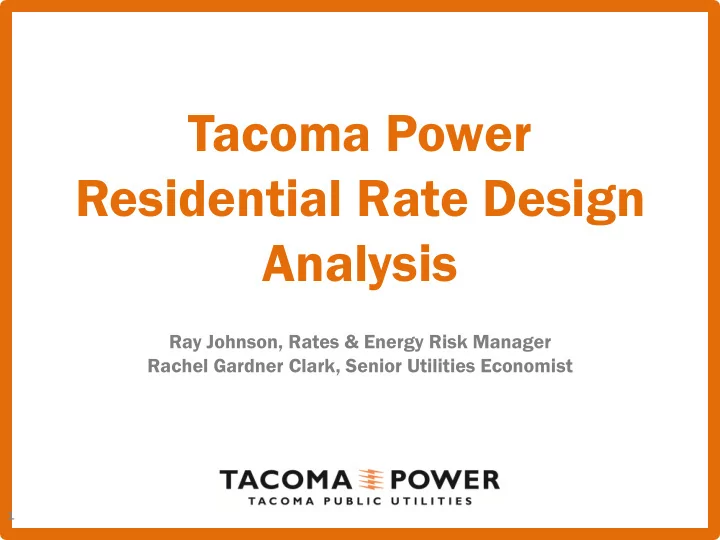

Tacoma Power Residential Rate Design Analysis Ray Johnson, Rates & Energy Risk Manager Rachel Gardner Clark, Senior Utilities Economist 1
Introduction About Tacoma Power Basic Stats 180 square miles of service area 155,000 residential customers 18,000 commercial customers Average use per household ≈ 11,000 kWh per year Relatively high share low-income Predominantly single-family residences 2
Introduction Residential Rate Design Study Timeline 1. Tacoma Power increased the customer charge in the previous rate process from $5.50 to 10.50 per customer per month What is the best rate 2. Staff had concerns about the impact of rate design on low- design for Tacoma income customers Power’s residential 3. Wanted 2017-18 policy recommendations to be based on customers? rigorous analysis 4. Convened team of staff experts to conduct study to understand impact of rate design on various demographics 5. Led to recommendation of putting 100% of increase into customer charge 3
Introduction Rationale 1. 1. Mitigat igates es the wor orst st imp mpac acts ts of a rate e increase ase. Spreads the bill increase evenly across customers and months Spread rate rather than saddling some customers with large bill increases evenly increases. across 2. Enhan 2. anced d finan ancia ial l stabili ability. Increasing the customer customers & charge achieves better alignment between fixed costs and fixed revenues. months 4
Introduction Put 100% of Increase into Customer Charge $84.05 $88.80 $93.55 $100 $90 $20.00 $4.75 $4.75 $15.25 $80 $10.50 $70 Cost per Month $60 $34.16 $34.16 $34.16 $50 $40 $30 $20 $39.39 $39.39 $39.39 $10 $- Current 2017 2018 Energy Delivery Customer Charge Usage based on 992 kWh/Month 5
Introduction Bill Assistance: Key Part of Proposal Bill Assistance Change Complements Rate Design Changes to Tacoma Power’s bill Tacoma Power highlighted changes to our bill assistance program as part of the residential rate assistance program proposal to the board significantly mitigate impacts Changing to a monthly distribution: complements to many low-income customers increase to customer charge Increased benefit Assistance increase fully offsets ts the proposed rate increase in 2017 Assistance increase partially tially offsets the cumulative increase in 2018 6
Introduction Study Overview Objective: Determine what rate design will minimize the negative impacts of upcoming rate increase Special focus on low income customers Approach: Home value as proxy for income Supplemented with data from Tacoma Power survey & Census Key Findings There is no “silver bullet” rate design that insulates low income customers from a rate increase Increasing the fixed charge mitigates the worst impacts of a rate increase 7
There is no Finding 1 silver bullet
Finding 1: There is no silver bullet Two contradictory stories about low-income customers Low-income = low-use: Low-income = high-use: More likely to live in apartments Low-income are more likely to be & smaller homes electrically heated Engage in more “behavioral Older, draftier homes conservation” Older appliances More likely to rent and face split incentives Implies higher er fixed ed, Implies lower fixed, lower volumetric is higher er volume metric tric is better for low income better for low income 9
Finding 1: There is no silver bullet Low-income customer consume less on average 10
Finding 1: There is no silver bullet But the relationship is very weak 98% of the variation in consumption cannot be explained Correlation = 0.16 by income 11
Finding 1: There is no silver bullet Implications for rate design Rate design is not a good tool for helping low-income customers 1. Lack of relationship between consumption and income means we cannot use rates to minimize impacts on low-income 2. No matter what the design, many low-income will be better off and many will be worse off 12
Increasing Finding 2 fixed charge mitigates the worst impacts
Finding 2: Increasing fixed charge mitigates the worst impacts of rate increase Avoids large bill increase for some Increasing the per-kWh charge puts many customers at risk of large bill increases Increasing the customer charge limits bill increases 14
Finding 2: Increasing fixed charge mitigates the worst impacts of rate increase Another View: Risk Tradeoff Some customer pay slightly more Fixed charge under fixed avoids the long charge tail of high bills 15
Finding 2: Increasing fixed charge mitigates the worst impacts of rate increase Avoids concentrating increases in winter Most customers’ bills increase more in winter if we raise per-kWh charge 75 th percentile Average 25 th percentile 16
Conclusion
Conclusion Final Thoughts 1. Increasing customer charge does not systematically help or harm low-income customers but does avoid concentrating the burden 2. Averages are not the whole story 3. All service areas are not the same 4. Combining skillsets 5. We are happy to provide additional detail 18
Questions? Rachel l Gardn dner Clark Ray Johnson son Energy Conservation Evaluator Manager, Rates & Energy Risk Tacoma Power Tacoma Power (253) 502-8291 (253) 441-4935 rclark2@cityoftacoma.org crjohnson@cityoftacoma.org
Recommend
More recommend